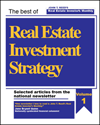Recommended real estate investment strategies
by John T. Reed


My approach
I was talking to a visitor to my Web site on the phone and I asked him if he understood what types of real estate investing I recommended. He said he did not and this was after he told me he had spent many hours reading my Web site. Seems like if you spend hours reading my Web site you ought to understand what I am in favor of as far as strategies are concerned.
The strategies I recommend
I recommend three categories of real estate investment strategies:
- bargain purchases
- upgrading
- double-digit cap rate acquisitions
Bargain purchases
A bargain purchase is one where you pay no more than 80% of the current market value of the property in question. That is not easy, but it’s doable. Generally, it’s done by buying in off-the-beaten-path ways like sheriff’s sales, foreclosure auctions, buying a partial interest in a home, and so forth.
And it can be done by buying “leper” properties. Those are properties that the vast majority of prospective buyers shun because they overreact to some adverse aspect of the property like pet urine smell, a tilted foundation, fire damage, flood damage, toxic contamination, and so forth.


My books How to Buy Real Estate for at Least 20% Below Market Value Volume 1 and Volume 2 explain the various ways to make bargain purchases.
Upgrading
In the upgrading strategy, you pay as much as current market value, but you then increase the value of the property by changing it in some way.
Most people assume that means cosmetic renovation. I used to think that. Not any more. It’s incorrect.
Cosmetic renovation is not profitable. Transaction costs are too high and the purchase prices on such houses are too high to leave room for a profit.
To profit from fixing a property, it must be a disaster when you buy it. Then you turn it into a fixer. You do not want to turn it into a perfect house because the newlyweds will underestimate the cost of taking it from fixer to perfect and therefore will overpay for fixers. They will not overpay for a perfect house.
For example, a house that would normally sell for $300,000 when perfect might sell for $200,000 because it has been condemned by the board of health for massive roof leaks or some such. You would buy it for $200,000 and spend, say, $40,000 correcting the worst problems so that the board of health reissues its occupancy permit. Although it still needs work, it is now inhabitable.
You then sell it for $280,000 to a newlywed couple. They figure it’s a bargain because homes in that neighborhood normally sell for $300,000. They figure they will fix it up themselves. In fact, it will cost $35,000 to do the fix up they intend counting the value of their time. But they are ignorant of how to make an accurate estimate and they value their own time at zero so they figure paying $280,000 for a $300,000 house that needs $35,000 more work is a good deal.
The only thing dumber than their analysis would be you doing all the fix-up thereby raising your total cost to $200,000 + $40,000 + $35,000 = $275,000 and cutting your profit from $40,000 to $25,000.


Get the fast buck not the last buck. See my book Fixers for details.
Intangible changes
Upgrading is not all tangible like renovation. There are also intangible upgrades like getting better zoning. For example, getting zoning changed to allow twice as many housing units per acre generally about doubles the value of vacant land.
There are other valuable intangible changes like getting a needed easement, changing the shape or size of the space offered for rent or sale to a more appropriate shape or size in the current market, and so forth.
My book on upgrading is called How to Increase the Value of Real Estate.
Double-digit cap rate acquisitions
In some rare, temporary, windows of opportunity in some markets you can buy real estate for a price so low in relation to the rental income that it has a double-digit cap rate, that is, at least 10%.
Cap rate is short for capitalization rate. It is the net operating income of a rental property divided by its value. Another way to think of it is that it is the cash-on-cash return the owner would get if he owned the property free and clear.
The net operating income is about 55% of the gross rents in a residential property. Many bad gurus depict much higher percentages of the gross rents being the owner’s net. They are lying to make real estate investment seem far more attractive than it actually is so they can sell their expensive seminars and “mentoring” services.
Also, many, if not most, real estate investors claim their own net operating income is much greater than 55%. They, too, are lying, or at least mistaken. They lie because they would be embarrassed to admit their true net. They also tend to be mistaken because they are sloppy about how they keep the books and their sloppiness is in the direction of making themselves look smarter and more successful than they really are. Typically they overstate their net because they leave out many operating expenses like vacancy and collection loss, repairs, replacements of capital items like roofs and refrigerators, and the value of their time.
You can see the actual full list and amounts of operating expenses in annual studies done by the Institute of Real Estate Management, National Apartment Association, Dallas Apartment Association, and so forth.
Double-digit cap rates happen when some disaster, natural or man-made, hits the community or region in question. The local people get so pessimistic about their own market that they refuse to buy. They rent, even paying more to rent than it would cost to buy the same property. That’s called positive cash flow from the landlord’s perspective. Why? Because they believe property values will fall. See my Web article on positive cash flow.
This happened in Anchorage, Alaska and Oklahoma City, OK during the oil glut in 1989. I would not be surprised if there were not similar opportunities in the Louisiana-Mississippi area after Katrina. A man told me he offered $1.2 million to buy a California home that was for sale for $1.6 million. The offer was rejected. Then the Southern California Northridge earthquake hit. He offered $1.1 million for the same home and it was immediately accepted. He said that the earthquake depressed property values in that area for about 18 months. Then people forget and values snap back to normal.
These opportunities typically only last about six months because outsiders recognize that the locals are overreacting to their temporary problem.
Strategies I do NOT recommend
I do not recommend the most common strategy which is buy and hold. Although I must say this is probably how most of the money made in real estate has been made.
In this “strategy,” you pay current market value and you typically buy through some mainstream channel like a multiple listing service. Then you simply hope that all properties go up in value, including yours.
People tend not to think of it, but the formula for this “strategy” is as follows:
Profit = sale price - purchase price - negative cash flow carrying costs during ownership - transaction costs of buying and selling - value of time spent to find, buy, manage, and sell the property
Requires high appreciation
What ambient marketwide appreciation rate is required to turn an adequate profit after all those expenses? A high one. A longer holding period than normal would reduce the transaction costs per dollar of appreciation, but that would also increase the cumulative negative cash flow and time spent by you.
The main problem I have with this strategy is that it is mindless. A chimpanzee could do this. It really is nothing but speculation. If you cannot forecast or control something that you “invest” in, then you are speculating on it. No can forecast or control ambient marketwide appreciation rates.
I recommend only strategies that rely on your intelligence and diligence, like bargain purchases, upgrading, and double-digit cap rates. I also only recommend strategies that work even if the ambient marketwide appreciation rate is zero. Because sometimes it is. Sometimes it’s even negative.
Young people may find that hard to believe. I am no longer young. I was born in 1946. I have seen the highest highs and the lowest lows in the real estate market. That is part of the wisdom of age. The young could acquire that wisdom by studying the past, but they rarely do.
Fortune cookie
If you just want to buy and hold and speculate on ambient marketwide appreciation rates, you do not need books, seminars, or “mentoring.” The information you need could all be put in a fortune cookie:
“Confucius say, buy real estate. It’s going up.”
Religion
When you think about it, this approach to real estate investing is religious. There is no supreme being in the real estate religion. But there is a tenet that is accepted on faith alone because no scientific evidence of future events can be obtained. The supreme tenet of the real estate religion is that real estate values always go up, not counting some occasional, temporary slumps.
I try to approach real estate scientifically and logically. I refuse to advise people to rely on blind faith.
Frosting on the cake
Note also that my recommended approach does not prevent you from benefiting from ambient marketwide appreciation. It’s just that you do not need it. If it occurs, it will be frosting on your bargain purchase, upgrade, or double-digit cake.
Other ‘strategies” I do not recommend
Nothing down
Many think that nothing down is a strategy. No, it isn’t. It’s a loan-to-value ratio, namely: 100%. Whatever strategy you adopt must have a profit-making component. There is not and cannot be a profit-making component in a loan-to-value ratio. Indeed nothing-down deals have bigger mortgages by definition and therefore bigger mortgage payments. That makes them even bigger money losers than deals with normal down payments. See my article on nothing down for more details.


Lease option
Similarly, a lease option is a legal document, not a strategy. True, if you are a sleazy, larcenous, con man, you can successfully use the lease-option document to bamboozle newlyweds into grossly overpaying to rent a house from you. But if you do, it is not the lease option that is making you money. It is the complexity of the document and the inability of the vast majority of newlyweds to understand what they are getting themselves into, combined with your willingness to take advantage of their babes-in-the-woods naivete. See my article on lease options.
Flipping
Flipping is not a strategy. It is a duration, namely hours or days or weeks. Flipping is really a form of the buy-and-hold strategy, albeit one with a very short holding period.
Actually, flipping is a myth. The bad gurus perpetrate the myth of flipping because it is one of the many ways they overcome the objection, “I don’t have any money to invest in real estate,” when they try to sell their multi-thousand dollar seminars or “mentoring” services.
There are some real-world flippers. In my experience and observation, they are relatively large real estate companies who have six or more people looking for bargain properties, another handful of people zooming in to repair them on closing day, and another half-dozen or more real estate agents who will instantly start to sell them once the investor-brokerage firm owner gets title to the property.
Flipping is a team sport. An individual, no matter how experienced, smart, or sophisticated, would not be able to flip properties profitably.
Flipping is also one of the most advanced and difficult ways to make money in real estate. You typically need to have substantial lines of credit in place to do it. That is something only established businesspeople can get. The notion that beginners should start out trying to flip houses is ridiculous.
Real flippers who do this profitably are really combining the bargain-purchase and upgrading strategies. They do not just hope values go up rapidly during their brief holding period. When you take into account transaction costs buying and selling, you would need enormous appreciation to make a profit. Run the numbers and you’ll see that appreciation alone won’t cover the transaction costs let alone make a profit.
See my Web articles on flipping and the TV show Flip That House for more detail.